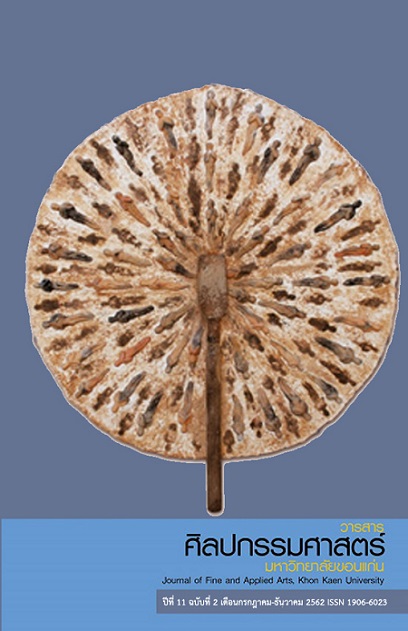Creativities of Paintings: Forms and Symbols on the rural way of life
Main Article Content
Abstract
The Propose of Painting Research Project : Forms and Symbols on the rural way of life, is to 1] study themes of creativity ; ‘Forms and Symbols on the rural way’. 2] Have reative paintings: Forms and Symbols on rural Way of life. 3] Have and present Artworks in an exhibition. The researcher found that in the old days, beautiful, graceful and meaningful way of rural life depends on the natural surroundings. People lived and touched closely the nature towards local wisdom as the base of living. People lived simply and casually. Simplicity and Casualty were noticeable because their instruments for living were evidently simple and easy such as tools for fishing, excavators, wicker works, handicrafts etc. The researcher sketched, based on former information and research study, simple layout by choosing forms and then create 7 paintings using semi non-figurative form and shapes. The symbols ; shape round, head of the farmer and a lot of tools for agriculture and fisheries were used and mixed techniques with natural materials and use ready-made are mainly significant. All materials with local techniques reflect locality by craftsman. The paintings show the real truth of materials that is certainly essential towards self-pure proof process of its own truth. The researcher arranged arts elements towards focus on principles of balances; Radial Balance and Symmetrical Balance. In order to arouse sensationally feelings and emotions that reflect local wisdom. The researcher gathers all artworks in order to show at the exhibition so that the visitors gain aesthetic taste and they have certainly acknowledgements by themselves while admiring these paintings ; one of creative artwork procedures that reveal thoughts, feelings and ideas. This function guides people everlastingly understand and recognize the value of human being
Article Details
Content and information in articles published in the Journal of Fine and Applied Arts of Khon Kaen University is regarded as the opinion and sole responsibility of the author(s) directly; therefore, editors are not obliged to agree to or share any responsibility with regard to the content and information that appears within these articles.
All articles, information, content, image, etc. that have been published in the Journal of Fine and Applied Arts of Khon Kaen University is the copyright of the Journal of Fine and Appllied Arts of Khon Kaen University. Any person or organization who wishes to distribute all or parts of the articles for further dissemination or other usage must first receive permission from the Journal of Fine and Applied Arts of Khon Kaen University before proceeding to do so.
References
จุรีรัตน์ ทวยสม. (2554). รอยวัฒนธรรมอีสาน. ศิลปกรรมศาสตร์ มหาวิทยาลัยขอนแก่น, ปีที่ 3 (ฉบับที่ 2), 51-52.
ชลูด นิ่มเสมอ. (2553). องค์ประกอบของศิลปะ. กรุงเทพฯ : อมรินทร์พริ้นติ้งแอนด์พับลิชชิ่ง.
ธีระ ปาลเปรม. (2560). ศิลปะวิสัย. มหาวิทยาลัยศิลปากร, ปีที่ 37 (ฉบับที่ 3), 151.
ปรีชา เถาทอง. (2559). เอกสารประกอบการบรรยายในงานสัมมนาวิชาการ 40 ปี มนุษยศาสตร์และสังคมศาสตร์ระดับชาติและนานาชาติ 22-24 สิงหาคม 2559. มหาสารคาม : คณะมนุษยศาสตร์และสังคมศาสตร์ มหาวิทยาลัยราชภัฏมหาสารคาม.
พิศรวัส ภูทอง และอัมพวัลย์ วิศวธีรานนท์. (2559). รูปแบบการจัดการแหล่งการเรียนรู้ในสถาบันอุดมศึกษาของรัฐ : กรณีศึกษาหอศิลปะและวัฒนธรรม. ศิลปกรรมศาสตร์ มหาวิทยาลัยขอนแก่น, ปีที่ 8 (ฉบับที่ 2), 5.
ราชบัณฑิตยสถาน. (2541). พจนานุกรมศัพท์ศิลปะอังกฤษ-ไทย. พิมพ์ครั้งที่ 2. กรุงเทพฯ : คุรุสภา.
อิทธิพล ตั้งโฉลก. (2550). แนวทางการสอนและสร้างสรรค์จิตรกรรมขั้นสูง. กรุงเทพมหานคร : อมรินทร์พริ้นติ้ง.


